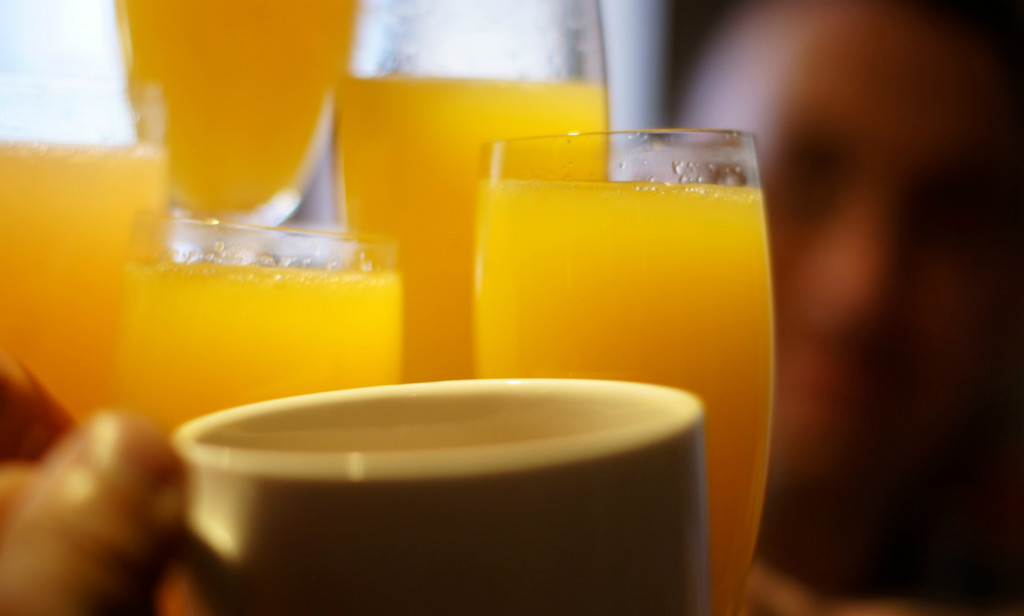

I never understood the point of brunch. When faced with hollandaise sauce, eggs benedict, and bloody marys stuffed to the brim with olives and bacon, I found myself asking one simple question: Why? Why do we need brunch, and where did this third circle of culinary Hell come from? While the public’s fascination with brunch has ultimately forced my hand into a sort of laissez-faire acceptance, the raison d’être of brunch, especially of the bottomless variety still remains unanswered. Moreover, as the son of two accountants, the economic viability of a tradition that sees D.C.’s 14th Street flooded with drunken hordes every Saturday and Sunday morning is of specific interest.
The origins of brunch vary depending on what food historian you ascribe to (Ivan Day is a good pick, if for no other reason than this picture), with some believing the meal has its roots in England’s hunt breakfasts. Others posit brunch “derives from the practice of Catholics fasting before mass and then sitting for a large midday meal.” Origins not withstanding, the first mention of the word “brunch” appeared in print in an 1895 Hunter’s Weekly article written by British author Guy Beringer aptly entitled “Brunch: A Plea.” In the article, Beringer argued for a “new meal, served around noon, that starts with tea or coffee” one that would eliminate “the need to get up early on a Sunday” and make life “brighter for Saturday night carousers.”
It took 38 years for brunch to become popular in the United States and, at least initially, its popularity was based on necessity. According to Evan Jones, author of American Food: The Gastronomic Story, brunch first came to Chicago due to the city’s location on transcontinental railways, whose schedules resulted in wealthy individuals frequently stopping off in Chicago to enjoy a late morning meal. Brunch as a casual meal gained a foothold in America’s dietary schedule after World War II. Not only were people looking for a new social outlet, but large numbers of American married women also entered the workforce for the first time. According to the late Stanford University professor Carl Degler, “married women needed a relief on Sunday, too, thus the rise in popularity of Sunday brunch eaten out.”
Brunch’s reputation as a meal of the wealthy extends to modern day. According to Google search data from 2015, interest in brunch is highest in New York, Massachusetts, Maryland, and Washington D.C. In fact, among the top 10 states for brunch interest, only Illinois and Pennsylvania are not on the coasts. Additionally, according to Washington Post writers Roberto Ferdman and Christopher Ingraham, “there is some relationship between a state’s median income and brunch interest” and a slightly stronger “relationship between brunch and the percentage of a state’s residents living in urban areas.” Surprisingly, Ferdman and Ingraham found that the strongest correlation was between brunch and a state’s Jewish population: states with higher percentages of Jewish residents tended to brunch more. For fans of famous Jewish comedian and New Yorker Larry David, the plethora of choice offered by brunch makes complete sense.
If the allure of brunch as a meal that “makes you satisfied with yourself and your fellow beings” is understandable, the rationale behind the bottomless brunch is slightly more convoluted. According to The Atlantic’s Derek Thompson, restaurants serve bottomless drinks with brunch for three primary reasons: peer pressure from other competitors that serve endless drinks, the amount of food one tends to eat while drinking, and — most importantly — “all the food and all the drink you order in the coming months when you return to that restaurant because you had such a good time.” That last reason is the most perplexing from a financial perspective. In effect, restaurants hedge their bets that bottomless drinks, which are almost always sold at a loss, incentivize customers to come back and spend more after the fact.
In theory, such an approach makes sense — lure in customers with bottomless drinks and reap the benefits of a customer’s loyalty later. But in reality, this is not always the case. Bottomless brunches adhere to Beringer’s 121-year-old call for late breakfast, but focus on the experience and not necessarily the food. And while endless mimosas made with “acrid, poor quality bubbly” help grease the wheels of conversation among friends, they fall short of building lasting rapport. Simply put, why remain loyal to a restaurant’s brunch menu when new, but ultimately familiar brunch experiences are always available.
From a restaurant’s perspective, bottomless brunch represents a catch-22: In order to retain customer loyalty and provide a distinguishing experience, restaurants have to provide better drinks and better food. In order to do so, more money has to be invested in food cost, which exacerbates the issue of declining profits (food margins are much, much narrower than those on booze). In a 2014 interview with Mark Fuller, owner of D.C. restaurants Proof, Doi Moi, and Estadio, Fuller was quoted as saying brunch at Estadio was “less profitable in the sense that revenue is less” and the restaurant generated “less revenue per hour than we do at dinner.”
Regardless of your opinion on bottomless brunch, remember that the next time you pay more than you expected for food and drink that didn’t exactly hit the mark, blaming your decisions on peer pressure is a valid excuse, most likely shared by the restaurant you’re in.
Ruben Gzirian is a pursuer of fine whiskeys, with Michter’s US*1 American Whiskey his current favorite. He holds an MA from the Middlebury Institute of International Studies and enjoys reading World War II history, with a focus on the Eastern Front.
Photo credit: Ted Eytan
